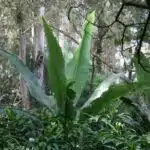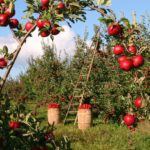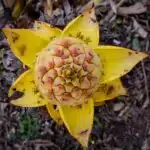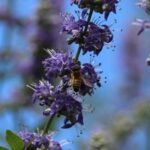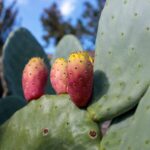Bananas are one of the most popular fruits in the world, providing a burst of energy and sweetness to meals, snacks, juices and desserts. But did you know that banana trees are just as special as their fruit? Banana trees are not only beautiful, but also hardy and easy to care for. In this article, we will explore the basics of banana tree care and growing guide.
The first step in caring for your banana tree is to select the right variety for your climate. Depending on where you live, there may be several varieties that can thrive in your environment. Once you have chosen your variety, it’s time to choose a spot for planting. Banana trees need at least six hours of direct sunlight per day and well-draining soil to thrive.
Finally, it’s important to maintain proper care throughout the year for your banana tree to survive and bear fruit. This includes regular watering, fertilizer application and pruning when needed. With proper care, you can expect your banana tree to produce delicious fruit within two or three years! Now that you know the basics of growing a banana tree, let’s dive into more details on how best to care for these unique plants!
Types Of Banana Trees
Banana trees are a beautiful, tropical addition to any landscape. They come in many shapes and sizes, boasting large, lush leaves and vibrant yellow fruits. From dwarf varieties that fit in containers to towering giants that can reach up to 20 feet tall, there’s a banana tree for every garden.
When selecting a banana tree, it’s important to understand the different types available. There are two main groups of banana trees: dessert bananas and cooking bananas. Dessert bananas include popular varieties like Cavendish and Valery, which bear sweet fruits with creamy flesh perfect for eating raw or adding to desserts. Cooking bananas have a firmer texture and are best used in dishes such as stews or curries.
No matter the type of banana tree chosen, proper care is essential for these tropical plants to thrive. With adequate sunlight and water, plus regular fertilization during the active growing season, your banana tree will produce delicious fruits for years to come.
Selecting A Banana Tree
Have you ever thought about growing a banana tree in your backyard? Selecting the right one is critical for successful cultivation. In this section, let’s take a look at what you need to know before purchasing one.
When considering a banana tree, think about your climate first. Not all varieties are suitable for every region. For example, Cavendish and Gros Michel varieties grow best in warmer climates with temperatures above 60°F (16°C). If you live in cooler climates, try Musa Basjoo which can survive even colder areas as low as -10°F (-23°C). You can also go for Musa acuminata or Musa balbisiana if you live in subtropical or tropical regions.
The size of your space should also be taken into account when selecting a banana tree. Dwarf bananas are ideal for smaller areas since they only reach between 5 and 8 feet (1.5-2.4 m) tall whereas taller varieties like Praying Hands and Rajapuri can reach up to 20 feet (6 m) in height! Lastly, choose the variety based on the type of fruit you’re looking for – sweet or tart, starchy or creamy – each variety has its own distinct flavor profile so make sure it fits your tastes!
Now that you’ve selected the right banana tree, it’s time to start planting!
Planting A Banana Tree
Planting a banana tree is not difficult, but it is important to get the process right. When selecting your banana tree, make sure you have chosen a variety that will thrive in your climate and soil conditions.
Once you’ve selected the right tree, you can begin planting. You’ll need to dig a hole at least twice as wide as the root ball of your banana tree and then fill the hole with soil mixed with organic compost or manure. Make sure to avoid adding too much fertilizer, as this can cause root burn.
Water your newly planted banana tree thoroughly and then add a layer of mulch around the base of it to keep moisture in and weeds out. With proper care taken during planting, your banana tree should be off to a good start! Now it’s time to move on to caring for your new plant.
Banana Tree Care
Going the extra mile is a must when it comes to caring for banana trees. From proper planting to ensuring the tree has enough nutrients, there are plenty of steps in between that require careful attention. In this section, we’ll provide an overview of banana tree care and what it entails.
Once planted, location is key for optimal growth and health. Banana trees prefer warm temperatures and lots of humidity, so make sure to plant in an area where these conditions can be met. Additionally, ensure your banana tree gets at least 8 hours of direct sunlight each day – otherwise it won’t produce fruit.
Ensuring your banana tree has enough moisture is another important factor in its overall health. Depending on weather and soil conditions, you may need to water your tree more or less frequently; however, it should never be allowed to dry out completely. To maintain the right level of moisture, mulch around the base of the tree with a thick layer of natural material such as pine needles or grass clippings. With the right care and attention, your banana tree will thrive!
Now that we’ve covered how to properly care for a banana tree, let’s move onto fertilization – the next step in keeping your plant healthy and happy!
Banana Tree Fertilization
When it comes to banana tree fertilization, there are a few things to keep in mind. Firstly, bananas are heavy feeders and need a lot of nutrients to grow and produce healthy fruit. They should be fertilized twice a month during the growing season, using a balanced fertilizer that contains all essential macronutrients. Additionally, you can supplement with micronutrients like magnesium, sulfur, and zinc if needed.
It’s important to note that over-fertilizing can be harmful to the plant. The fertilizer should also be applied at the base of the tree, not on its leaves or fruit. Furthermore, when applying fertilizer always make sure to water it in thoroughly afterward so that it doesn’t burn the roots of your banana tree.
Knowing when and how much fertilizer your banana tree needs is key for successful growth and healthy fruit production. With proper care and attention, you’ll soon have a thriving banana tree in your garden! Now that we’ve discussed fertilization let’s move on to discuss watering a banana tree next.
Watering A Banana Tree
When it comes to caring for a banana tree, watering is an important part of the process. It’s essential to keep the soil evenly moist, although not soggy. Too much or too little water can cause problems such as yellowing leaves, wilting, and root rot.
When watering a banana tree, make sure to use lukewarm water that has been left out overnight so it reaches room temperature. This will prevent shocking the roots with cold water and damaging them. Water slowly and deeply in order to thoroughly saturate the soil. Aim for about one inch (2.5 cm) of water per week during the growing season and reduce it during cooler months when growth slows down.
Banana trees are sensitive to chlorine and other chemicals in tap water, so if possible use rainwater or distilled water instead. If you must use tap water then let it sit out overnight before using it on your plant. Avoid getting any water on the foliage since this can cause fungal diseases, but feel free to mist the leaves occasionally if they seem dry. With proper watering techniques and following these guidelines, you’ll be able to ensure your banana tree is healthy and happy!
Looking after a banana tree also requires pruning in order to maintain its shape and encourage new growth.
Pruning A Banana Tree
Pruning is an important part of banana tree care. It helps to keep the plant healthy and encourages more productive fruiting. To properly prune a banana tree, you’ll need a sharp pair of shears or pruners. Start by removing any dead or damaged foliage from the entire plant. This will help reduce the risk of disease and pests.
Next, you’ll want to thin out any overcrowded clusters of leaves. This will allow for better air circulation and sunlight penetration, which will help promote vigorous growth and fuller, healthier looking foliage. Be sure to cut away leaves that are blocking the access to fruit clusters too, as this will make it easier for you to harvest them when they’re ready.
Finally, if your banana tree is growing too large for its space, you can remove some of the old stems at ground level. This will reduce its overall size and shape it into a more manageable form while still allowing it to produce fruit. Doing this on a regular basis can also stimulate new growth and extend the life of your banana tree significantly. By taking these steps now, you’ll be able to enjoy healthy, productive banana trees for years to come – but don’t forget about controlling pests and diseases!
Controlling Pests And Diseases
It is important to consider the possibility that pests and diseases may be detrimental to the health of a banana tree. To properly protect it, it’s crucial to understand how to keep these issues at bay.
Unfortunately, pests can quickly cause damage to a banana tree. To combat this possibility, regularly inspect the tree for signs of infestation. Keep an eye out for small holes in leaves or stems, as well as any discolored areas around the base of the trunk or on branches. If you spot any evidence of pests, use an appropriate insecticide solution to tackle them.
Diseases can also affect a banana tree’s health; however, there are some steps you can take to reduce their impact. Start by avoiding overwatering and using proper mulching techniques when applicable. Additionally, ensure that your tree is planted in an area with adequate air circulation and sunlight. If you follow these tips, it should help protect your banana tree from disease-related harm.
Protecting A Banana Tree From Cold
Protecting a banana tree from cold is like wrapping a beloved pet in a warm blanket. Ensuring the plant survives frigid temperatures requires extra attention and planning.
First, it’s important to be aware of the temperature range that your species of banana tree can tolerate; this varies depending on the variety. Once you know what temperatures your banana tree can handle, you’ll need to provide ample protection when cold weather hits. Mulching around the base of the trunk and covering the leaves with frost cloth are two methods that can help protect them from freezing temperatures. Additionally, it may be necessary to move potted plants indoors during extreme cold spells.
Finally, be sure to keep an eye on the forecast and any warnings issued by local authorities when severe weather is expected. Taking proactive steps to protect your plant will ensure it isn’t damaged by frost or extreme temperatures. Preparing for colder months ahead of time will save you heartache down the line as you look forward to watching your banana tree thrive in its new environment. Now let’s explore how to propagate a banana tree for even more success!
Propagating A Banana Tree
Propagating a banana tree is a great way to expand your banana tree collection and share the abundance. It’s relatively easy, especially since these plants are known for their rapid growth and multiple offshoots. There are two ways to propagate a banana tree: through division or from seed.
Division involves separating the rhizomes of an existing plant in order to create new ones. This method is best for those who want quick results because it produces viable plants much faster than growing from seed. However, division should only be attempted when the plant is mature enough and has several offshoots that can be divided, otherwise it can damage the original plant.
Growing a banana tree from seed requires more patience but allows you to experiment with different varieties of bananas. The seeds need to be soaked in water overnight before they can be planted in suitable soil, such as tropical potting mix or composted manure mixed with perlite or vermiculite. The temperature should also remain between 70-90 degrees Fahrenheit until germination occurs. With proper care and attention, you’ll have new banana trees sprouting up in no time!
With your newly propagated banana trees ready to go, it’s time to move onto the next stage: harvesting your fruit!
Harvesting Bananas
Harvesting bananas is a thrilling experience – the culmination of months of hard work and anticipation! It’s essential to know when to harvest the fruit so that it will be ripe and juicy. But how do you know when the bananas are ready for picking?
The first sign that your bananas are almost ready is when the skin starts to yellow. As the fruit continues to ripen, the skin will become more golden in color and will start to get brown spots on it. When you gently squeeze a banana, it should give slightly without being mushy. If it feels a bit too firm, then it’s not quite ready yet.
When harvesting, cut off each hand at its base using garden shears or scissors. Make sure to wear gloves if you have sensitive skin since handling the banana tree can cause irritation. Be careful not to damage any other parts of the plant as you remove each hand of fruit. With proper care, your banana tree should continue to produce delicious fruits year after year! Now onto discovering some different varieties of banana trees…
Banana Tree Varieties
Banana trees come in a variety of different types and varieties, each with their own unique characteristics. Some are grown for their sweet fruit, while others are grown mainly for their ornamental value. Regardless of the type you choose, it’s important to research and consider your climate before planting any banana tree.
Some popular varieties include the Dwarf Cavendish, the Grand Nain and the Giant Musa Basjoo. The Dwarf Cavendish is a small tree that produces sweet yellow fruit. The Grand Nain is known for its large size and sweet flavor. The Giant Musa Basjoo has bright green leaves and grows best in warmer climates.
No matter what type of banana tree you choose, proper care will help ensure that it thrives in your garden or landscape. Water regularly during dry periods and fertilize twice a year with an organic fertilizer made specifically for bananas. With a little bit of effort, you can have a healthy, productive banana tree in your yard! Looking ahead to the next step in growing a banana tree: containers.
Growing A Banana Tree In Containers
Growing a banana tree in containers is an option for those who don’t have the space for a full-sized tree or want to bring their plant indoors seasonally. It’s important to note that some of the larger varieties can’t be grown in containers as they need more space to grow. But if you have a smaller variety of banana tree, it’s quite possible to grow it in a container.
When growing your banana tree in a container, make sure you choose one that is large enough and has drainage holes so the roots won’t become waterlogged. You’ll also need to use potting soil specifically meant for tropical plants and fertilize regularly with a balanced fertilizer like 10-10-10 or 20-20-20. It’s also important to make sure your container has adequate sunlight and provide protection from extreme temperatures.
Taking good care of your banana tree will help ensure its success in a container environment. Make sure you keep the soil moist but not soggy, prune away any dead leaves or stems, and check for pests like aphids or mealybugs regularly. With proper care and attention, you can enjoy having your own banana tree right at home! And now that we’ve discussed growing them in containers, let’s take a look at some common questions about banana trees.
Common Questions About Banana Trees
Banana trees can be an exotic addition to any home, and growing them can be a rewarding experience. But with such a unique plant come questions that need answering–which is why the current H2 is so important. Questions about common banana tree issues like pests, temperatures, and fertilizers can all be answered in this section–a veritable oasis of knowledge for the curious gardener.
To begin with, it’s important to understand how long banana trees grow for and what kind of environment they thrive in. With proper care and warmth, banana trees can live for up to 10 years, making them a great option for those looking for something long-term. Additionally, they prefer warm climates and moist soil–a combination which makes them well suited to many areas around the world.
Finally, it’s important to consider potential problems that may arise when caring for a banana tree. From pests to diseases, there are many factors that could put your beloved plant in jeopardy. Knowing how to troubleshoot these issues quickly can help keep your tree safe from harm; fortunately, this guide provides helpful advice on how to do just that! With these tips in mind, you’re sure to have success with your own banana tree.
Troubleshooting Banana Tree Problems
When it comes to growing a banana tree, there are a few common problems you may face. From pests to poor soil conditions, banana trees are vulnerable to a variety of issues, and troubleshooting them requires careful assessment of the problem. In this article, we’ll explore some of the most common banana tree problems and how to address them.
The first issue that can arise is pests or diseases attacking the tree. Pests and diseases can be identified through observation — for example, brown spots on the leaves could indicate bacterial leaf spot disease. To treat these issues, use an appropriate pesticide or fungicide according to label instructions. Also, make sure that you’re properly pruning away any affected parts of the tree.
Another common issue is soil-related problems such as too much water or not enough nutrients in the soil. To resolve this problem, check the soil pH and adjust accordingly if necessary. Additionally, make sure that your banana tree is getting enough light and water by checking its environment regularly; too little light and water can cause yellowing leaves or stunted growth.
No matter what kind of problem arises with your banana tree, proper assessment and care are key in order to ensure its health and longevity. Taking steps such as providing adequate nutrition and monitoring for pests will go a long way towards keeping your banana tree happy!
Frequently Asked Questions
What Type Of Soil Is Best For Growing Banana Trees?
Banana trees are a tropical plant that thrive in warm climates, but they can also be grown in cooler regions with the right care. To ensure a healthy banana tree, you must provide it with the right kind of soil. So, what type of soil is best for growing banana trees?
The ideal type of soil for a banana tree is one that is rich and slightly acidic. It should be well-drained and loose to allow water to easily reach the roots; this is especially important during periods when there is limited rainfall. Compost or manure can be added to improve the soil’s structure and fertility. The pH level should be between 5.5 and 6.5 for optimal growth.
Banana trees need plenty of water, so if your soil doesn’t drain well then you may need to install drainage systems such as French drains or raised beds to ensure that their roots do not get waterlogged. Additionally, adding mulch around the base of the plant can help retain moisture in areas that experience extreme heat or drought conditions. With proper care and attention, you can have a healthy, productive banana tree!
How Often Should A Banana Tree Be Fertilized?
Fertilizing a banana tree is an important part of its care. Without adequate fertilizer, a banana tree won’t be able to reach its full potential and may struggle to bear fruit. But how often should you fertilize it?
The answer depends on the age of the banana tree and the type of fertilizer used. For young trees, it’s recommended to fertilize every other month with a nitrogen-based fertilizer. As the tree matures, you can decrease the frequency of fertilization to once every three months. If organic fertilizer is preferred, then monthly applications are necessary.
It’s also important to note that over-fertilizing can have serious consequences for your banana tree. Too much fertilizer can burn or even kill the roots, so it’s important to follow the recommended guidelines when applying any kind of fertilizer. If in doubt, it’s best to err on the side of caution and use less than more.
How Can I Prevent Banana Trees From Being Attacked By Pests And Diseases?
In today’s world of agriculture, it is important to protect your plants from pests and diseases. Banana trees are no exception; if you want to have a healthy and productive banana tree, you must take the necessary steps to prevent them from becoming attacked. So, how can we achieve this?
Well, for starters, the best way to keep pests away from your banana tree is by regularly inspecting it for signs of infestation. If you spot any bugs or other critters on your tree, take action immediately by applying an insecticidal soap or a natural pesticide such as neem oil. Additionally, make sure to remove any fallen fruit or leaves that could be harboring unwanted guests.
Another great preventative measure is to practice crop rotation each year. This involves planting different crops in the same area over a period of time so that certain pests and diseases don’t have time to build up in the soil. Finally, adding compost or mulch around the base of the banana tree will help add nutrients and beneficial bacteria into the soil which can help fight off disease-causing organisms.
With these simple steps, you can ensure that your banana tree remains protected from harmful pests and diseases while reaping the rewards of a bountiful harvest!
How Cold Can A Banana Tree Tolerate?
Banana trees are a tropical plant, so many people assume that they can’t tolerate cold temperatures. But the truth is, banana trees are surprisingly hardy! They can withstand colder temperatures than you might think—but how cold can a banana tree really handle? It’s an important question for anyone looking to cultivate this versatile and delicious fruit.
It turns out that banana trees can tolerate temperatures as low as 25 to 27 degrees Fahrenheit—an absolute shocker! This makes them an ideal crop for even the chilliest of climates. In fact, some varieties of bananas will even survive temperatures dipping down into the teens for short periods of time. It’s almost unbelievable that such a large and leafy tree could be so resilient against extreme temperatures, but it’s true: with careful attention and maintenance, your banana tree could thrive even in near-Arctic conditions.
At the same time, while they may be tough plants, there are still precautions to take when growing bananas in cold regions. Make sure to cover your banana tree before winter arrives, and monitor it closely throughout any unusually cold spells. With these extra steps in place, you’ll be able to protect your beloved banana tree from the chilly elements—and enjoy its sweet fruits year after year!
How Do I Know When To Harvest My Bananas?
Harvesting your banana tree’s fruit can be a tricky process. Knowing when to pick the bananas is key to enjoying their full flavor. Fortunately, there are several signs you can look for to know when your bananas are ripe and ready for harvesting.
First of all, pay attention to the color of the bananas. Ripe bananas will have moved from green to yellow or brown in color. The tips of the bananas will also be slightly soft when they’re ripe. Additionally, their skin may begin to show some slight dark spots or streaks of black or brown.
Finally, you can tell when your bananas are ripe by simply smelling them. Ripe banana fruits will give off a sweet scent that is unmistakable. If you’re still unsure, gently squeeze the tip of the banana and see if it yields slightly under pressure—another sure sign it’s time to harvest!
Conclusion
Banana trees are a great addition to any garden, and with the proper care and maintenance, you can enjoy a plentiful harvest of delicious bananas. Knowing the best type of soil to use, how often to fertilize your tree, and how to protect it from pests and diseases are all key elements in producing an abundant crop. Additionally, understanding when to harvest your bananas is essential in ensuring they’re ripe and ready for consumption. Taking these simple steps will help you grow a healthy banana tree that can produce an abundance of fruit each season.
Simile-wise, caring for your banana tree is like taking care of a child; you need to provide the right environment, nourishment and protection for it to thrive. With the right attention and dedication, you’ll be rewarded with a lush green garden full of succulent bananas that will make mouths water around the globe!
In conclusion, growing banana trees can be both rewarding and enjoyable if done correctly. Understanding what type of soil works best for this tropical plant as well as knowing when it’s time to harvest its fruit are both important factors in achieving success with this endeavor. With patience and proper care, you too can enjoy delicious fresh bananas straight from your own backyard!







